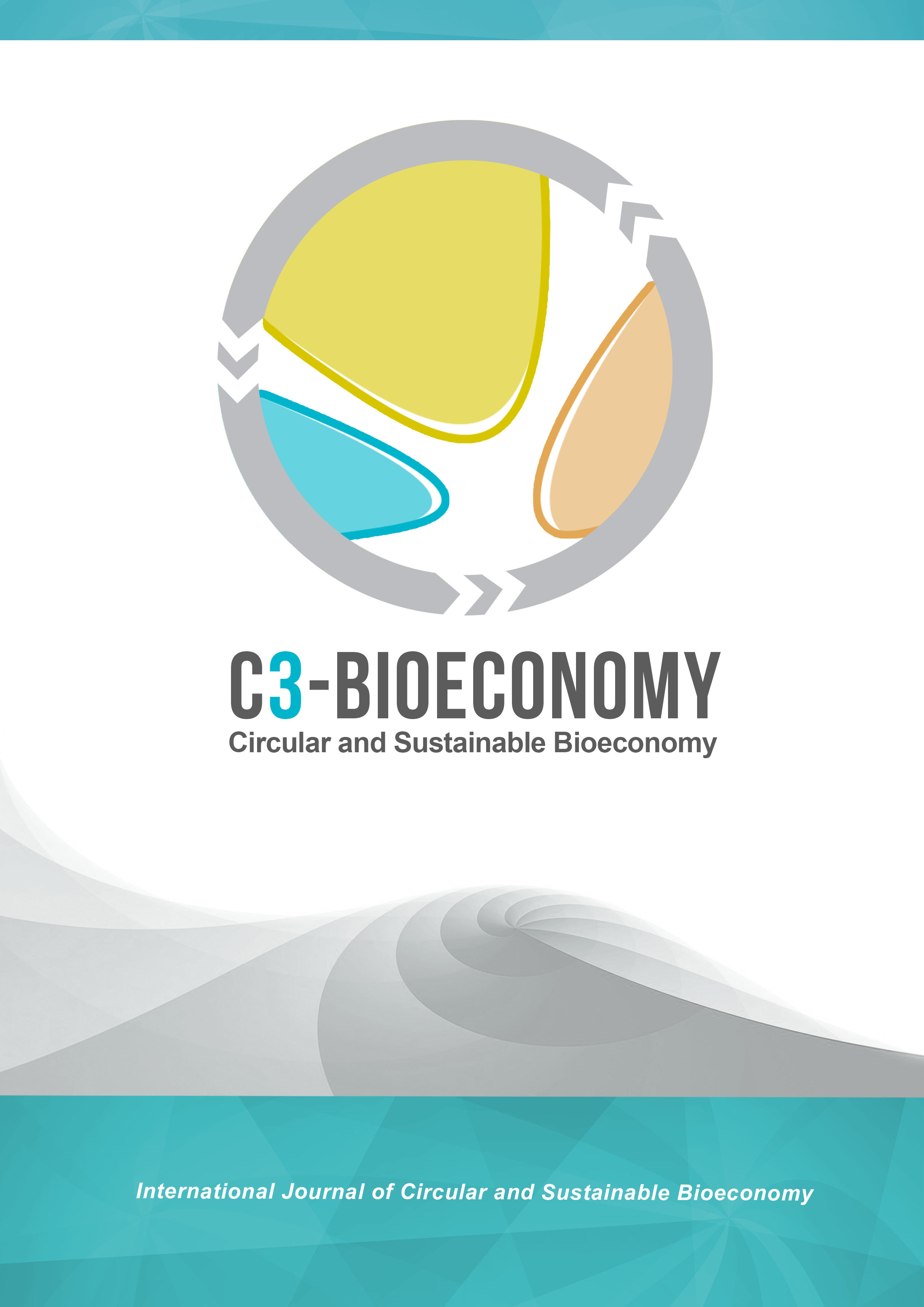Bioeconomy, strategies and impact
Main Article Content
Abstract
Bioeconomy has been in existence for fifteen years and in those years, it has spread to more than fifty countries and regions around the world. It emerged as a means of seeking an alternative to an economy based exclusively on the exploitation of oil and other fossil resources. Each specific bioeconomy is adapted by its nature to the climate, agricultural, industrial and socioeconomic development of a country or region and to its political environment. At present, there is a great consensus at a global level that the bioeconomy must be circular, sustainable, use renewable raw materials and accept the ecological limits of the planet. The experience of these years allows us to reflect on how to increase the impact of the bioeconomy by learning from those successful experiences. In this article the following themes are proposed: need for coherence between the bioeconomy and other policies; generate a broad social and political consensus; strategies and action plans must be inclusive and combine strategies with concrete actions. It also advances some considerations between the concepts of bioeconomy, sustainability and biodiplomacy.
Downloads
Article Details

This work is licensed under a Creative Commons Attribution-NonCommercial-NoDerivatives 4.0 International License.
Proposed policy for journals offering open access. Those authors who publish in this journal accept the following terms:
a) Authors will retain their copyrights, but guarantee the journal the right to the first publication of their work, which will be simultaneously subject to the Creative Commons Recognition License , which allows third parties to share the work provided that the author and initial publication in this journal is indicated.
b) Authors may subscribe other non-exclusive license agreements for the distribution of the work published (for example: place it in an institutional electronic archive, or publish it in a topical volume) provided that the initial publication in this journal is duly noted.
Authors are allowed and even encouraged to disseminate their work via the Internet (e.g., in institutional electronic files or on their website) before and during the submission process, as this can foster valuable exchanges and increase citations of the work published. (See The effect of open access).
References
AGUILAR, A., MAGNIEN, M. & THOMAS, D. (2013). Thirty years of European biotechnology programmes: from biomolecular engineering to bioeconomy. New Biotechnology, 5, 410-425. https://doi.org/10.1016/j.nbt.2012.11.014.
AGUILAR, A. & PATERMANN, C. (2020). Biodiplomacy, the new frontier for bioeconomy. New Biotechnology, 59, 20-25. https://doi.org/10.1016/j.nbt.2020.07.001.
AGUILAR, A., RAMÓN, D. & EGEA, F.J. (Eds.) (2018). Bioeconomía y desarrollo sostenible. Cajamar Caja Rural. Recuperado de: https://www.publicacionescajamar.es/publicaciones-periodicas/mediterraneo-economico/mediterraneo-economico-31-bioeconomia-y-desarrollo-sostenible.
AGUILAR, A., TWARDOWSKI, T. & WOLHGEMUTH, R. (2019). Bioeconomy for sustainable development. Biotechnology Journal, 14(8), 1800638, 1-11. https://doi.org/10.1002/biot.201800638.
Bioeconomy Policy-Synopsis and Analysis of Strategies in the G7. (2015). Berlin, Office of the German policy Council. Recuperado de: https://gbs2020.net/wp-content/uploads/2020/04/BOER_Laenderstudie_1_.pdf.
Bioeconomy Policy (Part II). Synopsis of National Strategies around the World. (2015). Berlin, Office of the German policy Council. Recuperado de: https://biooekonomierat.de/fileadmin/international/Bioeconomy-Policy_Part-II.pdf.
Bioeconomy Policy (Part III) Update Report of National Strategies around the World. (2018). Berlin, Office of the German policy Council. Recuperado de: https://biooekonomierat.de/fileadmin/Publikationen/berichte/GBS_2018_Bioeconomy-Strategies-around-the_World_Part-III.pdf.
Communiqué Global Bioeconomy Summit 2015. Making Bioeconomy work for Sustainable Development. (2015). Global Bioeconomy Summit. Recuperado de: https://gbs2015.com/fileadmin/gbs2015/Downloads/Communique_final_neu.pdf.
El Pacto Verde Europeo. Comunicación de la Comisión al Parlamento Europeo, al Consejo, al Comité Económico y Social y al Comité de las Regiones. COM/2019/640 final. (2019). Recuperado de: https://eur-lex.europa.eu/legal-content/ES/TXT/?uri=CELEX:52019DC0640.
En route to the Knowledge-Based Bio-Economy in Europe (2007). German Presidency of the European Union. Cologne. Recuperado de: https://dechema.de/dechema_media/Downloads/Positionspapiere/Cologne_Paper.pdf.
European Commission (2002). Life sciences and biotechnology, a strategy for Europe. Communication from the Commission to the European parliament, the Council, the Council, the Social and Economic Committee and the Committee of the Regions. Recuperado de: https://eur-lex.europa.eu/%20LexUriServ/LexUriServ.do?uri=COM:2002:0027:FIN:EN:PDF.
European Commission (2012). Innovating for sustainable growth. A bioeconomy for Europe. Recuperado de: https://ec.europa.eu/research/bioeconomy/pdf/official-strategy_en.pdf.
European Commission. (2018). A sustainable bioeconomy for Europe: strengthening the connection between economy, society and the environment. Updated bioeconomy strategy. Recuperado de: https://ec.europa.eu/research/bioeconomy/pdf/ec_bioeconomy_strategy_2018.pdf.
European Commission. (2020). World Bioeconomy Forum 2020. Recuperado de: https://ec.europa.eu/jrc/en/event/conference/world-bioeconomy-forum-2020.
European Commission. International ocean governance: an agenda for the future of our oceans. (2019). Recuperado de: https://ec.europa.eu/maritimeaffairs/policy/ocean-governance_en.
European Commission, Food 2030. (2015). Recuperado de: https://ec.europa.eu/info/research-and-innovation/research-area/bioeconomy/food-2030_es.
International Advisory Council on Global Bioeconomy, IACGB. (2020). Expanding the Sustainable Bioeconomy – Vision and Way Forward. Communiqué of the Global Bioeconomy Summit 2020. Recuperado de: https://gbs2020.net/wp-content/uploads/2020/11/GBS2020_IACGB-Communique.pdf.
International Advisory Council on Global Bioeconomy, IACGB. (2020). Global Bioeconomy Policy Report (IV): A decade of bioeconomy policy development around the world. Recuperado de: https://gbs2020.net/wp-content/uploads/2020/11/GBS-2020_Global-Bioeconomy-Policy-Report_IV_web.pdf.
MARVIK, O.J., PHILP, J. (2020). The systemic challenge of the bioeconomy. A policy framework for transitioning towards a sustainable carbon cycle. EMBO Reports, 21(10), 1-6. https://doi.org/10.15252/embr.202051478.
MENGAL, Ph., WUBBOLTS, M., ZICA, E., RUIZ, A, BRIGITT, D., PIENIA, A. & BLACK, S. (2018). Bio-based Industries Joint Undertaking: The catalyst for sustainable bio-based economic growth in Europe. New Biotechnology, 40 Part A, 31-39. https://doi.org/10.1016/j.nbt.2017.06.002.
National Bioeconomy Blueprint (2012). The White House. Washington. Recuperado de: https://obamawhitehouse.archives.gov/sites/default/files/microsites/ostp/national_bioeconomy_blueprint_april_2012.pdf.
PATERMANN, C. & AGUILAR, A. (2018). The origins of the bioeconomy in the European Union. New Biotechnology, 40 Part A, 20-24. https://doi.org/10.1016/j.nbt.2017.04.002.
Reglamento (UE) n ° 560/2014 del Consejo, de 6 de mayo de 2014, por el que se establece la Empresa Común para las Bioindustrias. Diario Oficial de la Unión Europea. L 169/130, 7.6.2014, p. 130–151. Recuperado de: https://eur-lex.europa.eu/legal-content/ES/TXT/PDF/?uri=CELEX:32014R0560&from=ES.
RUIZ SIERRA, A., ZICA, E., LANGE, L., LLORENTE RUIZ DE ARZÚA., P., CANALISA, A., MALLORQUÍN ESTEBAN, P., PAIANO., P. & MENGAL, Ph. (2020). The bio-based industries joint undertaking: A high impact initiative that is transforming the bio-based industries in Europe. New Biotechnology, 60, 105-112. https://doi.org/10.1016/j.nbt.2020.09.003.
The Bioeconomy to 2030: designing a policy agenda. (2009). OECD. Recuperado de: https://www.oecd.org/futures/long-termtechnologicalsocietalchallenges/thebioeconomyto2030designingapolicyagenda.htm.
ULRICH VON WEIZSÄKER, E. & WIJKMAN, A. (2018). Come on! Capitalism, short-termism, population, and the destruction of the planet. Club of Rome. New York, Springer.
WOHLGEMUTH, R., TWARDOWSKI, T. & AGUILAR, A. (2021). Bioeconomy Moving Forward Step by Step – A Global Journey. New Biotechnology, 61, 22-28. https://doi.org/10.1016/j.nbt.2020.11.006.

